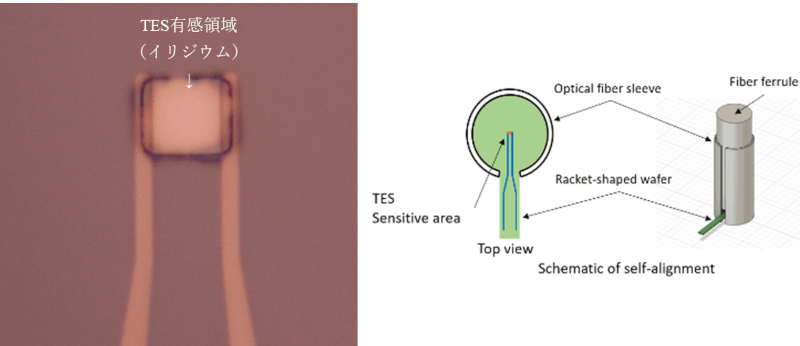Progress Report
Development of Large-scale Fault-tolerant Universal Optical Quantum Computers[2] Research and development on superconducting photon number discriminator
Progress until FY2024
1. Outline of the project
Quantum entanglement is generated by squeezed light and a beam splitter, and GKP qubits(qubits encoded by an error correcting code for continuous variables proposed by Gottesman, Kitaev and Preskill) are generated by detecting a predetermined number of photons. The GKP qubit appears at the moment when a predetermined number of photons is detected. We are developing a high-speed photon number resolving detector for GHz clock optical quantum computers. A superconducting transition edge sensor (TES) in the communication wavelength band can resolve the number of photons. TES is operated at the superconducting transition edge, by setting a proper operation temperature.
The temperature rise triggered by the absorption of near-infrared incident photons is read out as a current drop which corresponds to an absorbed energy. In order to realize high-speed TES operation, we will fabricate a device that minimizes the size of the sensor so that the temperature rise can propagate immediately over the entire sensor and the current change occurs instantaneously. The sensor size is to be minimized, thus the corresponding heat capacity is minimized, which contributes to the higher temperature rise. Therefore, higher S/N ratio, faster signal, and better identification of the number of photons are expected.
2. Outcome so far
The lower left figure shows a photograph of the fabricated 8 mm square TES. The TES is made on a silicon substrate, processed to have an outer shape that matches the size of the optical component, and is self-aligned so that it can be aligned with the optical fiber. It was confirmed that the fabricated TES showed a rise time of 16.2 ns and a corresponding bandwidth of ~20 MHz.

Typically, TES readouts are performed using SQUIDs, but in the fiscal year 2023, we demonstrated that direct readout using a HEMT (High Electron Mobility Transistor) circuit operating at low temperatures can achieve higher speeds. On the other hand, since TES is usually biased using a low impedance constant voltage bias circuit, connecting HEMT readout circuits in parallel creates signal loss. Therefore, we considered inserting an inductor between the bias circuit and the TES to separate them. In this case, the input coil of the SQUID can be utilized as this inductor. Since SQUIDs can achieve low noise, they are also suitable for photon number resolution. Thus, we used this separated circuit with SQUID elements to perform the readout of optical signals. As a result, we achieved a signal bandwidth of 68 MHz, exceeding the initially targeted operating bandwidth of 50 MHz. Additionally, the dynamic range was also achieved up to 60 photons.

3. Future plans
In simulation calculations, a rise time of 300 ps and a signal bandwidth of 1.2 GHz are expected, and further miniaturization of the devices will be advanced. We are progressing with the processing of sensor shapes using Focused Ion Beam (FIB). With FIB, it is possible to arbitrarily form fine structures, enabling the fabrication of devices with complex structures such as array structures, which can be expected to lead to greater speeds.